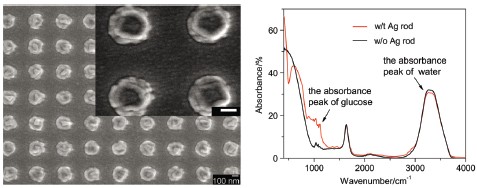| [1] Wang, K.; Long, H.; Fu, M.; Yang, G.; Lu, P.-X. Opt. Lett. 2010, 35, 1560. [2] Cui, B.; Lin, H.; Zhao, X.-C.; Li, J.-B.; Li, W.-D. Acta Phys.-Chim. Sin. 2011, 27, 2411. (崔柏, 林红, 赵晓冲, 李建保, 李文迪, 物理化学学报, 2011, 27, 2411.)[3] Choi, J.-R. Chin. Phys. B 2010, 19, 010306.[4] Todorov, Y.; Tosetto, L.; Teissier, J.; Andrews, A.-M.; Klang, P.; Colombelli, R.; Sagnes, I.; Strasser, G.; Sirtori, C. Opt. Express 2010, 18, 13886.[5] Shen, L.-F.; Chen, X.-D.; Zhang, X.-F.; Agarwal, K. Plasmonics 2011, 6, 301.[6] Zhang, Y.-Y.; Zhang, J. Acta Chim. Sinica 2012, 70, 2293. (张莹莹, 张锦, 化学学报, 2012, 70, 2293.)[7] Fan, J.-F.; Zhao, C.-X.; Fan, L.-Z. Acta Chim. Sinica 2012, 70, 229. (范建凤, 赵晨醒, 范楼珍, 化学学报 2012, 70, 229.) [8] Hibbins, A.-P.; Evans, B.-R.; Sambles, J.-R. Science 2005, 308, 670.[9] Song, G.-F.; Wang, W.-M.; Cai, L.-K.; Guo, B.-S.; Wang, Q.; Xu, Y.; Wei, X.; Liu, Y.-T. Acta Phys. Sin. 2010, 59, 5105. (宋国峰, 汪卫敏, 蔡利康, 郭宝山, 王青, 徐云, 韦欣, 刘运涛, 物理学报, 2010, 59, 5105.)[10] Wang, Y.; Wang, X.; He, X.-J.; Mei, J. S.; Chen, M.-H.; Yin, J.-H.; Lei, Q.-Q. Acta Phys. Sin. 2012, 61, 137301. (王玥, 王暄, 贺训军, 梅金硕, 陈明华, 殷景华, 雷清泉, 物理学报, 2012, 61, 137301.)[11] Li, Y.; Lin, Z.; Li, R.-Z.; Liu, X. Acta Chim. Sinica 2012, 70, 1304. (李迎, 林钊, 李蓉卓, 刘霞, 化学学报, 2012, 70, 1304.)[12] Liu, X.; Sun, Y.; Song, D.-Q.; Tian, Y.; Zhang, H.-Q.; He, Y. Acta Chim. Sinica 2007, 65, 2544. (刘霞, 孙颖, 宋大千, 田媛, 张寒琦, 何彦, 化学学报, 2007, 65, 2544.) [13] Wang, Q.; Zhu, H.-Z.; Yang, X.-H.; Wang, K.-M.; Yang, L.-J.; Ding, J. Acta Chim. Sinica 2012, 70, 1483. (王青, 朱红志, 羊小海, 王柯敏, 杨丽娟, 丁静, 化学学报 2012, 70, 1483.) [14] Quidant, R.; Girard, C. Laser & Photon. Rev. 2008, 2, 47.[15] Davoyan, A.-R.; Shadriivov, I.-V.; Kivshar, Y.-S. Opt. Express 2008, 16, 21209.[16] Zhang, R.-J.; Qi, Z.-M.; Zhang, Z. Acta Phys.-Chim. Sin. 2011, 27, 1757. (张蓉君, 祁志美, 张喆, 物理化学学报, 2011, 27, 1757.)[17] Zhang, Z.-Y.; Du, J.-L.; Guo, Y.-K.; Niu, X.-Y.; Li, M.; Luo, X.-G.; Du, C.-L. Chin. Phys. Lett. 2009, 26, 014211.[18] Zhang, Z.-Y.; Du, J.-L.; Guo, X.-W.; Luo, X.-G.; Du, C.-L. J. Appl. Phys. 2007, 102, 074301.[19] Lv, J.-T.; Wang, F.-W.; Ma, Z.-H.; Si, G.-Y. Acta Phys. Sin. 2013, 62, 057804. (吕江涛, 王凤文, 马振鹤, 司光远, 物理学报, 2013, 62, 057804.)[20] Jiang, X.-X.; Gu, Q.-C.; Wang, F.-W.; Lv, J.-T.; Ma, Z.-H.; Si, G.-Y. Mater. Lett. 2013, 100, 192. [21] Si, G.-Y.; Zhao, Y.; Liu, H.; Teo, S.; Zhang, M.; Huang, T.-J.; Danner, A.-J.; Teng, J. Appl. Phys. Lett. 2011, 99, 033105.[22] Hong, Q.-H.; Liu, X.-F.; Fang, Y. Acta Chim. Sinica 2013, 71, 255. (洪清华, 刘雪锋, 方云, 化学学报, 2013, 71, 255.) [23] Tan, Y.; Ding, S.-H.; Wang, Y.; Qiang, W.-P. Acta Chim. Sinica 2005, 63, 929 (谈勇, 丁少华, 王毅, 钱卫平, 化学学报, 2005, 63, 929.) [24] Khoury, C.-G.; Norton, S.-J.; Vo-Dinh, T. ACS Nano 2009, 3, 2776.[25] Guo, B.; Shan, W.-W.; Luo, J.-S.; Tang, Y.-J.; Cheng, J.-P. Acta Chim. Sinica 2008, 66, 1435 (郭斌, 单雯雯, 罗江山, 唐永建, 程建平, 化学学报, 2008, 66, 1435.) [26] Gao, Q.; Qian, Y.; Xia, Y.; Jiang, C.-Y.; Qiang, W.-P. Acta Chim. Sinica 2011, 69, 1617. (高倩, 钱勇, 夏炎, 蒋彩云, 钱卫平, 化学学报, 2011, 69, 1617.) [27] Si, G.-Y.; Zhao, Y.-H.; Lv, J.-H.; Wang, F.-H.; Liu, H.-L.; Teng, J.-H.; Liu, Y.-J. Nanoscale 2013, 5, 4309.[28] Ke, S.-L.; Kan, C.-X.; Mo, B.; Cong, B.; Zhu, J.-J. Acta Phys.-Chim. Sin. 2012, 28, 1275. (柯善林, 阚彩侠, 莫博, 从博, 朱杰君, 物理化学学报, 2012, 28, 1275.)[29] Yao, J.; Liu, Z.; Liu, Y.; Wang, Y.; Sun, C.; Bartal, G.; Stacy, A.-M.; Zhang, X. Science 2008, 321, 930.[30] Kabashin, A.-V.; Evans, P.; Pastkovsky, S.; Hendren, W.; Wurtz, G.-A.; Atkinson, R.; Pollard, R.; Podolskiy, V.-A.; Zayats, A.-V. Nat. Mater. 2009, 8, 867.[31] Lemoult, F.; Fink, M.; Lerosey, G. Nat. Commun. 2012, 3, 889.[32] Wurtz, G.-A.; Pollard, R.; Hendren, W.; Wiederrecht, G.-P.; Gosztola, D.-J.; Podolskiy, V.-A.; Zayats, A.-V. Nat. Nanotechnol. 2011, 6, 107.[33] Kleinman, S.-L.; Sharma, B.; Blaber, M.-G.; Henry, A.-I.; Valley, N.; Freeman, R.-G.; Natan, M.-J.; Schatz, G.-C.; Van Duyne, R.-P. J. Am. Chem. Soc. 2013, 135, 301.[34] Xie, H.-N.; Larmour, I.-A.; Smith, W.-E.; Faulds, K.; Graham, D. J. Phys. Chem. C 2012, 116, 8338.[35] Hwang, E.; Smolyaninov, I.-I.; Davis, C.-C. Nano Lett. 2010, 10, 813.[36] Kravets, V.-G.; Schedin, F.; Grigorenko, A.-N. Phys. Rev. Lett. 2008, 101, 087403.[37] Auguié, B.; Barnes, W.-L. Phys. Rev. Lett. 2008, 101, 143902.[38] Atay, T.; Song, J. H.; Nurmikko, A.-V. Nano Lett. 2004, 4, 1627. |
